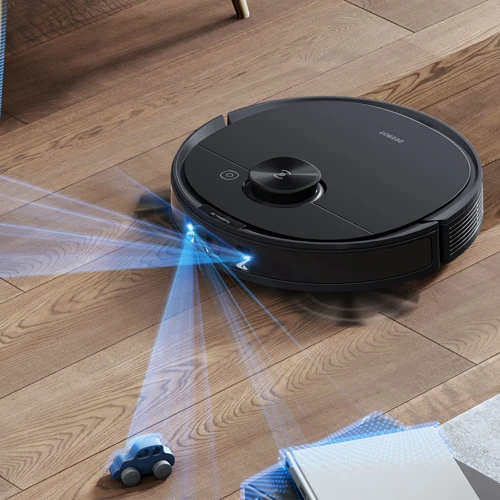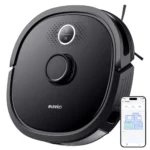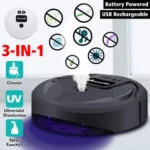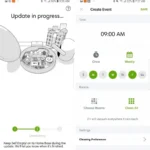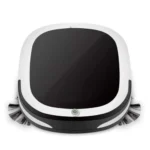As we all know, keeping our homes clean can be a tedious and time-consuming task. Thanks to technological advancements, however, we can now rely on smart vacuum cleaners to take care of this chore efficiently. One of the essential features of these devices is obstacle detection technology. But what exactly is it, and how does it work? In this article, we will explore the benefits of obstacle detection in smart vacuum cleaners and how it improves their overall performance. We will also dive into the various factors that you need to consider when choosing an obstacle detection smart vacuum cleaner. Let’s get started!
What is Obstacle Detection Technology?
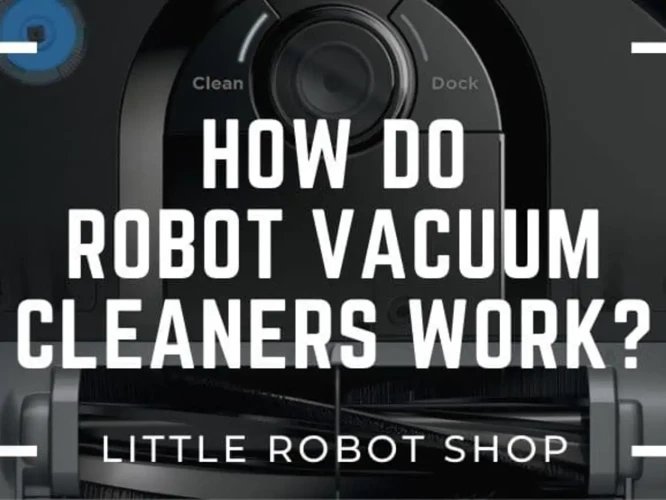
Have you ever wondered how smart vacuum cleaners navigate through tight spaces without bumping into obstacles? The answer lies in the obstacle detection technology that enables these devices to detect and avoid any obstacles that come in their way. With obstacle detection technology, smart vacuum cleaners can roam freely around the house without any human intervention, providing a hassle-free cleaning experience. In this section, we’ll delve deeper into the mechanism behind obstacle detection technology and explore the various sensors that make it possible. To learn more about the benefits of obstacle detection in efficient cleaning with smart vacuum cleaners, check out our detailed article.
How Does It Work?
Obstacle detection technology is critical for smart vacuum cleaners’ efficient and hassle-free cleaning. The technology works by utilizing sensors that detect obstacles in the vacuum cleaner’s path, thus preventing collision damage, and improving its navigation and cleaning capabilities.
These sensors come in various forms, including infrared sensors, laser sensors, and ultrasonic sensors. Some vacuum cleaners even combine multiple sensors to enhance their obstacle detection capabilities.
Here’s a table that summarizes the different types of obstacle detection sensors and their functions:
| Sensor Type | Function |
| — | — |
| Infrared sensors | Emit infrared rays to detect obstacles in the vacuum cleaner’s path |
| Laser sensors | Use laser technology to detect objects in the vacuum cleaner’s path |
| Ultrasonic sensors | Use sound waves to identify obstacles in the vacuum cleaner’s path |
When the vacuum cleaner comes across an obstacle, the sensors send signals to the vacuum cleaner’s circuit board, which then adjusts the vacuum cleaner’s movement accordingly or halts it completely, thus preventing any potential collision damages.
Obstacle detection technology enables smart vacuum cleaners to detect hidden corners and hard-to-reach places. The sensors provide real-time feedback on the vacuum cleaner’s location and the obstacles in its path, allowing it to steer itself accurately and navigate through challenging spaces.
Integrating obstacle detection technology in smart vacuum cleaners has revolutionized the cleaning industry, and as the technology advances, it is expected to offer more innovative features. Whether you are a homeowner or a cleaning professional, smart vacuum cleaners’ obstacle detection technology is an essential tool to improve cleaning efficiency.
If you want to learn more about how obstacle detection technology improves smart vacuum cleaners’ performance, please check out our article on smart vacuum cleaners’ obstacle performance. If you’re interested in integrating obstacle detection technology into your smart home, read our article on integrated obstacle detection in smart home. You can learn more about the technology itself in our article on smart vacuum cleaner obstacle technology.
The Types of Obstacle Detection Sensors
Obstacle detection sensors in smart vacuum cleaners are designed to recognize and avoid obstacles. They help the vacuum cleaner move around the room without bumping into walls, furniture, or other objects. There are different types of obstacle detection sensors that manufacturers use to ensure optimal performance.
1. Infrared Sensors: Infrared sensors are commonly used in smart vacuum cleaners. They emit a beam of infrared light that bounces back when it hits an obstacle. The sensor then detects the object’s location, size, and distance, allowing the vacuum cleaner to steer around it. Infrared sensors are relatively cheap and reliable, but they only work within a limited range.
2. Collision Sensors: Collision sensors are usually mounted on the body of the vacuum cleaner. They detect physical contact with an obstacle and send signals to the vacuum cleaner’s microprocessor, which then adjusts the robot’s movement. Collision sensors are effective but can damage the furniture they collide with.
3. Encoder and Tachometer Sensors: Encoders track the number of rotations made by the robot’s motor. Tachometers, on the other hand, measure the speed of the motor. By combining these two sensors, smart vacuum cleaners can determine their exact position and distance travelled. This helps the vacuum cleaner to navigate around obstacles with more precision.
4. Ultrasonic Sensors: Ultrasonic sensors emit high-frequency sound waves that bounce back when they hit an object. The sensor then calculates the distance and shape of the object based on the time taken for the sound waves to return. Ultrasonic sensors are effective in detecting objects even in low light conditions, but they can be costly.
5. Anti-Drop Sensors: Vacuum cleaners typically use anti-drop sensors to prevent falls down stairs or off ledges. These sensors use infrared light to detect the edge of a surface, such as a step or a ledge. When the vacuum cleaner reaches the edge, it will stop and retreat, preventing it from falling.
Choosing a smart vacuum cleaner with advanced obstacle detection sensors is essential for optimal performance. The table below summarizes the different types of sensors and their key features.
| Sensor Type | Key Features |
|---|---|
| Infrared Sensors | Reliable but limited range |
| Collision Sensors | Effective but can damage furniture |
| Encoder and Tachometer Sensors | High precision |
| Ultrasonic Sensors | Effective in low light conditions |
| Anti-Drop Sensors | Prevent falls and damage |
Obstacle detection sensors are an essential component of smart vacuum cleaners. They help the robot to navigate through a room safely and efficiently. The type of sensor used can impact the performance of the vacuum cleaner, so it’s crucial to choose a robot with sensors appropriate for your home’s layout and furniture.
The Benefits of Obstacle Detection in Smart Vacuum Cleaners
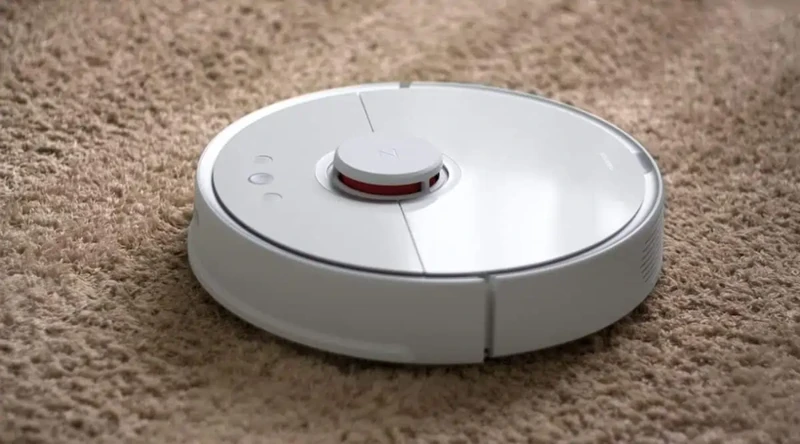
Smart vacuum cleaners have revolutionized the way we clean our homes. With the introduction of obstacle detection technology, these devices have become even more efficient and effective. By using advanced sensors, smart vacuum cleaners can navigate around obstacles and clean hard-to-reach areas with ease. This technology offers many benefits that can simplify your cleaning routine and save you time and effort. Let’s take a closer look at how this technology works and the benefits it provides.
Efficient Cleaning in Less Time
One of the major benefits of obstacle detection technology in smart vacuum cleaners is that it leads to efficient cleaning in less time. Let’s explore how this works:
- Saves time: Obstacle detection sensors in smart vacuum cleaners can detect obstacles in their path and quickly navigate around them. This helps to save time because the vacuum cleaner can effortlessly switch from one direction to another without stopping or slowing down. The accurate mapping of the room allows the vacuum cleaner to ‘understand’ the layout of the house and the areas that require cleaning. As a result, it can clean faster than traditional vacuum cleaners by avoiding unnecessary movements.
- Multi-functional cleaning: Obstacle detection technology enables smart vacuum cleaners to perform multiple cleaning actions at the same time. The vacuum cleaner can detect the different surfaces it’s cleaning and adjust its cleaning power accordingly. For example, when cleaning carpets or rugs, the vacuum cleaner will automatically increase its suction power, and when cleaning hardwood floors or tiles, it will adjust to a lower setting. This ability to multitask is a huge time-saver compared to manual cleaning techniques.
- Precision cleaning: With obstacle detection sensors, smart vacuum cleaners can accurately determine the positions of dirt and dust around the house. This helps them to zero in on these areas and effectively clean them without the need for multiple passes. Precision cleaning ensures that every nook and cranny is thoroughly cleaned, leading to a healthier, dust-free environment.
Obstacle detection technology in smart vacuum cleaners reduces cleaning time without compromising quality. It ensures that the cleaning process is precise, accurate, and fast, leading to a more efficient cleaning experience.
Prevents Collision Damages
Obstacle detection technology in smart vacuum cleaners prevents collision damages and protects your furniture and walls. Ordinary vacuum cleaners can cause bumps and scratches on furniture and walls that can be costly to repair. However, smart vacuum cleaners equipped with obstacle detection sensors can navigate around the room and avoid any obstacles in their way. This feature reduces the likelihood of damaging your furniture and also ensures a safer cleaning process.
The Benefits of Obstacle Detection in Preventing Collision Damages
| Benefits | Explanation |
|---|---|
| Protects Furniture and Walls | Obstacle detection sensors allow the smart vacuum cleaner to detect any obstacles in its path and navigate around them, reducing the likelihood of bumping into furniture and walls which can cause damage. |
| Reduced Maintenance Costs | Smart vacuum cleaners with obstacle detection technology help minimize the need for costly repairs to furniture and walls resulting from bumps or scratches during cleaning. |
| Extended Lifespan of Appliances | By reducing the likelihood of accidental collisions with furniture and walls, the lifespan of your smart vacuum cleaner can be extended, reducing the frequency of costly replacements. |
Obstacle detection technology in smart vacuum cleaners helps prevent any accidental collisions or damages during cleaning, making it a worthwhile investment for protecting your home and appliances.
Spotless Cleaning in Hard-to-Reach Places
One of the amazing benefits of obstacle detection technology in smart vacuum cleaners is spotless cleaning in hard-to-reach places. With obstacle detection sensors, these devices can easily navigate around tight spaces, furniture legs, and other obstacles on their own, making it easier for them to reach areas that would otherwise be difficult to clean.
Obstacle detection technology makes it possible for the smart vacuum cleaner to recognize the obstacle in front of it and find a way to avoid it without human intervention. This feature allows the device to clean under beds, tables, and other furniture where dust and dirt tend to accumulate.
Some smart vacuum cleaners have distinct cleaning modes that focus on hard-to-reach places, allowing them to clean corners and edges with meticulous precision. These devices can adjust their cleaning heads, suction power, and brush rolls to ensure that they clean every nook and cranny in your home.
To give an example, the Roomba i7+ uses a Dual Multi-Surface Rubber Brush that is specifically designed to extract dirt and pet hair from hard-to-reach places, ensuring that your home is spotlessly clean. This assisted vacuum cleaner also has a high-efficiency filter that captures 99% of dust, dirt, and allergens as small as 10 microns.
The obstacle detection technology enables smart vacuum cleaners to clean in areas that are hard to reach for traditional vacuum cleaners, making them more effective in ensuring that every part of your home is thoroughly cleaned.
| Benefits of Obstacle Detection Technology in Smart Vacuum Cleaners |
|---|
| Effortlessly navigate around tight spaces and furniture legs |
| Reach areas that are difficult to clean |
| Clean under furniture and other hard-to-reach spaces |
| Can focus on cleaning modes that tackle every nook and cranny |
| Specific cleaning tools designed to extract dirt and pet hair |
Energy-Efficient Operations
When it comes to cleaning the house, efficient and energy-saving operations are two factors that play a crucial role. Fortunately, smart vacuum cleaners equipped with obstacle detection technology offer both of these benefits. Let’s take a closer look at how they achieve energy-efficient operations.
One of the ways smart vacuum cleaners with obstacle detection technology achieve energy efficiency is by conserving battery power through their ability to detect obstacles. Vacuum cleaners without this technology may continue moving around obstacles or run into them. This not only wastes time and decreases efficiency, but it also drains the battery unnecessarily. With obstacle detection technology, the vacuum cleaner can quickly detect and navigate around obstacles, which saves time and energy.
Another way in which smart vacuum cleaners promote energy efficiency is through their ability to navigate smoothly and swiftly around the house. With obstacle detection sensors, these cleaning machines are less likely to become stuck under furniture or entangled in cables, which can result in a significant waste of energy and time. By avoiding getting stuck, they can clean more area in less time, which means less energy consumption overall.
Smart vacuum cleaners use specialized sensors to detect areas that need more cleaning or have been cleaned already. By doing this, smart vacuums don’t spend time cleaning areas that don’t require attention, which helps conserve energy. This is particularly useful for busy and oversized living spaces, where the vacuum can navigate and detect when to “lighten up” on certain areas.
All of these features combine to make smart vacuum cleaners with obstacle detection technology great energy-efficient home cleaning machines. Their ability to detect and navigate around obstacles like furniture or sidetrack it when avoiding them can help conserve battery power as well as improve cleaning efficiency. Ultimately, investing in a smart vacuum cleaner with obstacle detection technology is an excellent way to achieve a clean home without wasting energy.
| Benefits of Energy-Efficient Smart Vacuum Cleaners with Obstacle Detection Technology |
|---|
| Conserves battery power: Obstacle detection technology prevents the vacuum from getting stuck or wasting battery power moving around obstacles and helps it clean more area in less time. |
| Smooth navigation: Smart vacuums are less likely to get stuck under furniture or entangled in cables, which helps conserve energy and saves time. |
| Targeted cleaning: Smart vacuums use specialized sensors to detect areas that need more cleaning or have been cleaned already, which helps conserve energy by avoiding unnecessary cleaning. |
How Obstacle Detection Technology Improves Smart Vacuum Cleaners
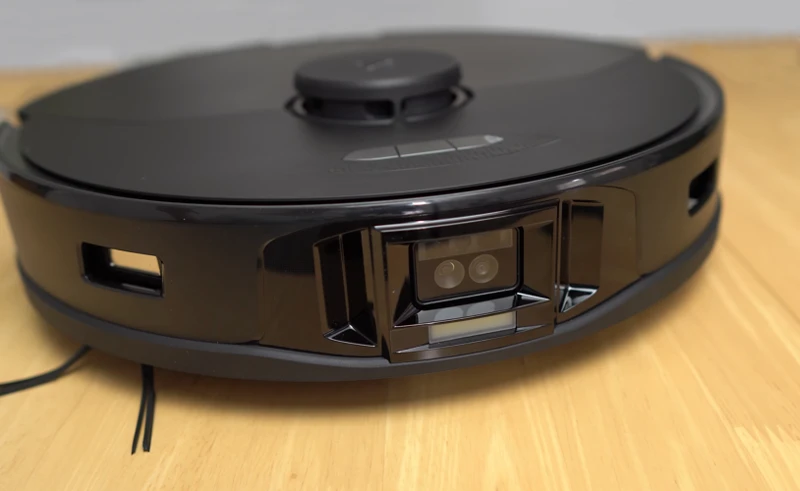
As the demand for smart living solutions continues to rise, manufacturers strive to develop innovative features for their products. Obstacle detection technology is one such feature that enhances the performance of smart vacuum cleaners. With this technology, the cleaning process becomes more effective, efficient, and hassle-free. Let’s dive deeper into the ways obstacle detection technology improves smart vacuum cleaners and how it benefits the user.
Intelligent Mapping & Navigation Features
One of the main benefits of obstacle detection technology in Smart Vacuum Cleaners is the ability to provide intelligent mapping and navigation features. This advanced technology empowers Smart Vacuum Cleaners to move around the house seamlessly, creating maps of the cleaning areas and navigating around obstacles to ensure thorough cleaning.
Here are some of the key mapping and navigation features offered by obstacle detection technology:
- Room detection: With the help of obstacle detection sensors, Smart Vacuum Cleaners can detect the boundaries of rooms and map out a cleaning plan accordingly. This ensures that every corner of the room is cleaned with precision.
- Furniture detection: Smart Vacuum Cleaners equipped with obstacle detection sensors can detect the presence of furniture and navigate around them efficiently. This ensures that your furniture is protected from accidental bumps and scratches while ensuring every nook and corner is properly cleaned.
- Stair detection: One of the most beneficial aspects of obstacle detection technology is that it can detect stairs and navigate around them. This provides significant safety benefits, ensuring that the Smart Vacuum Cleaner does not fall off the edge of a staircase, causing damage or injury.
Apart from avoiding obstacles, obstacle detection technology also ensures that Smart Vacuum Cleaners perform the cleaning task with precision and efficiency. Mapping and navigation features enable the Smart Vacuum Cleaner to create a cleaning plan by identifying the cleaning areas and their progress. This improves cleaning efficiency, ensuring that no area is left uncleaned.
With obstacle detection sensors, Smart Vacuum Cleaners can navigate around the house with ease, avoid potential damage or accidents, and perform their cleaning tasks with precision and efficiency.
Real-Time Feedback & Control
One of the key advantages of obstacle detection technology in smart vacuum cleaners is the ability to provide users with real-time feedback and control. This technology allows the vacuum cleaner to detect and respond to changes in the cleaning environment, ensuring that cleaning is carried out as efficiently and effectively as possible.
Real-time feedback and control is made possible through the use of advanced sensors and mapping technology. As the smart vacuum cleaner moves throughout the space, it creates a detailed map of the environment, noting the location of obstacles and other potential hazards. This map is continually updated in real-time as the vacuum cleaner moves throughout the space, allowing it to adjust its cleaning pattern and avoid obstacles as needed.
Table:
| Advantages of Real-Time Feedback and Control in Smart Vacuum Cleaners | |
|---|---|
| Efficient Cleaning | The ability of the vacuum cleaner to adjust its cleaning pattern in real-time ensures that cleaning is carried out efficiently and without interruption. |
| Optimized Performance | Real-time feedback and control allows the vacuum cleaner to optimize its performance based on changing environmental factors, ensuring that the cleaning process is carried out as effectively as possible. |
| Customizable Cleaning Preferences | Real-time feedback and control allows users to control the cleaning process based on their specific preferences, ensuring that cleaning is carried out exactly as desired. |
| Reduced Maintenance Needs | The use of real-time feedback and control ensures that the vacuum cleaner is able to avoid obstacles and other potential hazards, reducing the likelihood of collisions and minimizing maintenance needs over time. |
Real-time feedback and control also allows for customizable cleaning preferences. Users can define what areas need more attention and where they want the vacuum cleaner to clean less. By adjusting its cleaning pattern in real-time, the vacuum cleaner can meet these needs, allowing users to achieve spotless cleaning without having to worry about any particular areas being missed.
Another advantage of real-time feedback and control is that it reduces maintenance needs over time. The vacuum cleaner is able to avoid obstacles and other potential hazards, minimizing the likelihood of collisions and other forms of damage. This lowers the maintenance cost and prolongs the lifespan of the vacuum cleaner, saving the users from the unnecessary expenses.
The use of obstacle detection technology in smart vacuum cleaners with real-time feedback and control offers significant benefits to users. These vacuum cleaners are not only efficient and effective, but they also offer users complete control over the cleaning process, allowing them to achieve spotless cleaning with minimal effort.
Automated Cleaning & Scheduling Options
One of the major benefits of obstacle detection technology in smart vacuum cleaners is the presence of automated cleaning and scheduling options. This feature allows users to customize their cleaning preferences and schedule the cleaning according to their convenience.
The automated cleaning function saves time and effort for users. Smart vacuum cleaners with obstacle detection sensors can detect and navigate around obstacles while cleaning. This implies that users do not need to intervene manually to move the vacuum cleaner or lift it over an obstacle. Additionally, with the automated cleaning function, users can clean their entire house or specific rooms with just a click of a button.
The scheduling option is another impressive feature of smart vacuum cleaners equipped with obstacle detection technology. This feature enables users to schedule the cleaning according to their preferences. For example, users can schedule the vacuum cleaner to clean the house when nobody is home, ensuring that the cleaning does not interfere with their daily activities. With the scheduling option, users can set the frequency of cleaning, ensuring that their house remains clean at all times.
The following table summarizes the benefits of the automated cleaning and scheduling options in smart vacuum cleaners equipped with obstacle detection technology:
| Benefits of Automated Cleaning & Scheduling Options in Smart Vacuum Cleaners |
|---|
| Saves time and effort for users |
| Users do not need to intervene manually to move the vacuum cleaner or lift it over an obstacle |
| Cleans the entire house or specific rooms with just a click of a button |
| Users can schedule the cleaning according to their preferences |
| Cleaning does not interfere with users’ daily activities |
| Users can set the frequency of cleaning to ensure that their house remains clean at all times |
The automated cleaning and scheduling options of smart vacuum cleaners equipped with obstacle detection technology provide a convenient and hassle-free cleaning experience for users. Investing in a smart vacuum cleaner with obstacle detection sensors can save time and effort, allowing users to focus on other important tasks.
Factors to Consider When Choosing an Obstacle Detection Smart Vacuum Cleaner
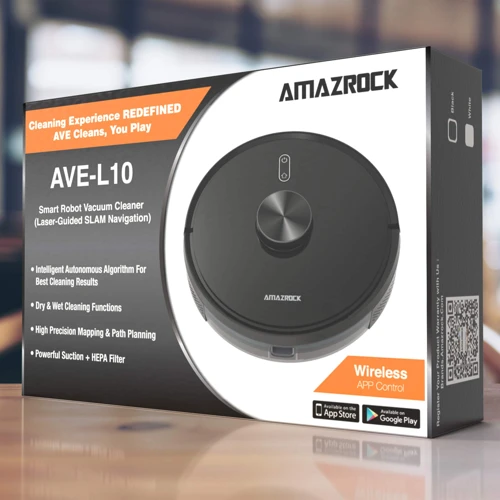
When choosing an obstacle detection smart vacuum cleaner, there are several important factors to consider to make the best decision for your cleaning needs.
Type of Obstacle Detection Sensors: Different obstacle detection sensors have varying capabilities, so it’s essential to know the type of sensors used in a smart vacuum cleaner. For example, some vacuum cleaners use infrared sensors, while others use laser sensors. Depending on your home’s layout and furniture arrangement, one type of sensor may be more effective than another.
Battery Life: The battery life of the smart vacuum cleaner is another important factor to consider. It’s essential to choose a model with sufficient battery life to cover the necessary cleaning area without requiring frequent recharging. Some models have the capability to return to their charging station automatically, which saves you the trouble of having to recharge them manually.
Cleaning Features: Some smart vacuum cleaners come with additional cleaning features, such as mopping and sweeping functionalities. These additional features can provide a more comprehensive cleaning solution for your home. Additionally, some models come with HEPA filters or other advanced filtering systems, which can be beneficial in homes with pets or allergy sufferers.
Brand and Price: When choosing a smart vacuum cleaner, the brand and price point are also important factors to consider. While it may be tempting to choose the cheapest option available, it’s essential to choose a reputable brand that offers a warranty or customer support in case you need assistance. It is also important to compare prices and features of different models to find the best value for your money.
Compatibility with Smart Home Systems: Finally, it is crucial to check if the smart vacuum cleaner you are considering is compatible with your home’s smart home system or whether it is possible to control it with your preferred virtual assistant. This will enable you to control your vacuum cleaner remotely through your smartphone or voice-enabled speakers.
By considering these factors when choosing an obstacle detection smart vacuum cleaner, you can find the perfect model that fits your cleaning requirements and preferences.
Should You Invest in an Obstacle Detection Smart Vacuum Cleaner?
Investing in an obstacle detection smart vacuum cleaner can make cleaning a hassle-free experience for you. These smart vacuum cleaners come equipped with advanced sensors that help them navigate through obstacles and clean your home effectively. However, before making the decision to invest in one, there are a few factors you should consider.
Cost
Like any other high-tech cleaning appliance, obstacle detection smart vacuum cleaners come at a premium price. When deciding to invest in one, you should consider your budget and the value it will bring to your home. While they can be costly, with their advanced technology, they can save you time and effort in the long run.
Size of Home
The size of your home should also be taken into consideration before investing in an obstacle detection smart vacuum cleaner. Depending on the size of your home, you may need a more powerful machine or one that has a longer battery life. It’s important to choose a vacuum cleaner that can accommodate your home’s specific cleaning needs.
Types of Flooring
The type of flooring in your home is another important factor to consider. Obstacle detection smart vacuum cleaners are designed to work on a variety of surfaces, including carpets, hardwood, and tiles. However, before purchasing one, make sure it is compatible with the type of flooring you have at home, as some models have limitations.
Cleaning Needs
Finally, consider your cleaning needs. If you have pets that shed a lot, you may need a vacuum cleaner with stronger suction power or one that has a specialized pet hair cleaning tool. If you have hard-to-reach places in your home, a vacuum cleaner with a longer reach and more flexible attachments may be necessary. It’s important to assess your cleaning needs and choose a vacuum cleaner that can meet them.
Investing in an obstacle detection smart vacuum cleaner can be a great decision, especially if you value convenience and efficiency in your cleaning routine. However, before making a purchase, it’s important to consider factors such as cost, the size of your home, the types of flooring, and your cleaning needs. By doing so, you’ll be able to select the right vacuum cleaner that can cater to your specific cleaning requirements, and make cleaning a breeze.
Conclusion
In conclusion, the implementation of obstacle detection technology in smart vacuum cleaners is truly a game-changer in the cleaning industry. Not only does it provide more efficient cleaning in less time, but it also prevents collision damages and allows for spotless cleaning in hard-to-reach places.
Moreover, these smart vacuum cleaners with obstacle detection sensors are energy-efficient and provide automated cleaning and scheduling options, making them a great investment for any household or workplace.
When considering investing in an obstacle detection smart vacuum cleaner, it is important to take into account factors such as the type and sensitivity of the sensors, the mapping and navigation features, as well as the overall capability and design of the machine.
Overall, the benefits of obstacle detection technology in smart vacuum cleaners cannot be overstated. It not only improves the cleaning process but also makes it hassle-free and easy for the user. So, if you’re looking for a smart and efficient way to keep your space clean, choosing an obstacle detection smart vacuum cleaner may just be the solution you’ve been looking for.
Frequently Asked Questions
1. How does obstacle detection technology work in smart vacuum cleaners?
Obstacle detection technology in smart vacuum cleaners uses sensors to identify and avoid objects in its path.
2. What are the types of obstacle detection sensors in smart vacuum cleaners?
The types of obstacle detection sensors in smart vacuum cleaners include infrared, ultrasonic, and laser.
3. What are the benefits of obstacle detection technology in smart vacuum cleaners?
The benefits of obstacle detection technology in smart vacuum cleaners include efficient cleaning, collision prevention, spotless cleaning in hard-to-reach places, and energy-efficient operations.
4. How does obstacle detection technology improve the performance of smart vacuum cleaners?
Obstacle detection technology improves the performance of smart vacuum cleaners by enabling intelligent mapping and navigation, real-time feedback and control, and automated cleaning and scheduling options.
5. Can obstacle detection technology help prevent my smart vacuum cleaner from damaging my furniture?
Yes, obstacle detection technology can help prevent your smart vacuum cleaner from damaging your furniture by using sensors to detect and avoid collisions.
6. Are smart vacuum cleaners with obstacle detection technology more expensive than those without it?
Yes, smart vacuum cleaners with obstacle detection technology are generally more expensive than those without it, but the extra cost is worth it for the added convenience and efficiency.
7. Can smart vacuum cleaners with obstacle detection technology be controlled remotely?
Yes, many smart vacuum cleaners with obstacle detection technology can be controlled remotely through a smartphone app or voice control.
8. What should I consider when choosing a smart vacuum cleaner with obstacle detection technology?
When choosing a smart vacuum cleaner with obstacle detection technology, factors to consider include the type of sensors used, the level of mapping and navigation capabilities, and the cost and brand reputation of the device.
9. Do I need to manually program my smart vacuum cleaner with obstacle detection technology to avoid obstacles?
No, smart vacuum cleaners with obstacle detection technology use sensors and algorithms to automatically detect and avoid obstacles in their path.
10. Are there any drawbacks to using a smart vacuum cleaner with obstacle detection technology?
The biggest potential drawback to using a smart vacuum cleaner with obstacle detection technology is that the sensors can be prone to false alarms or inaccuracies, leading to missed areas or reduced efficiency.
